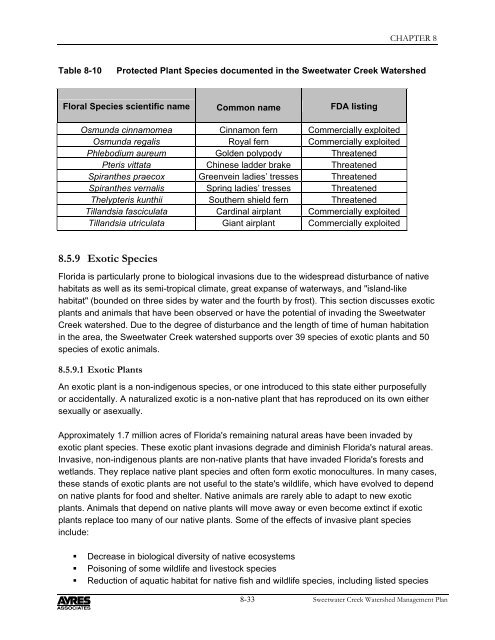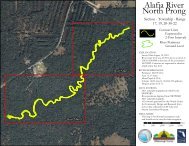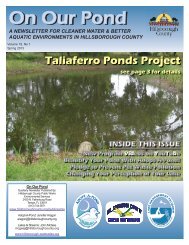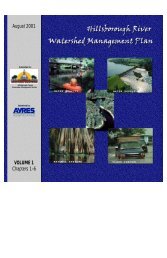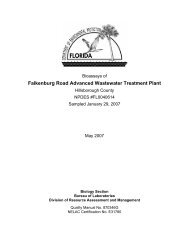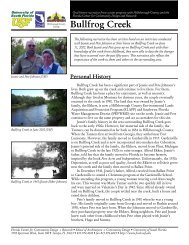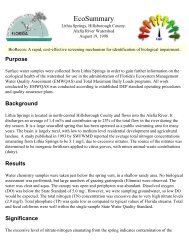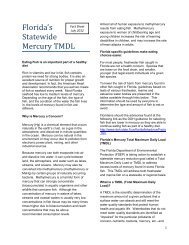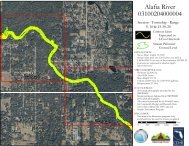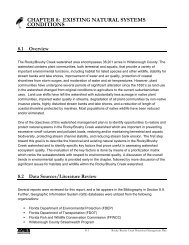Sweetwater Creek Watershed Mgmt. Plan 2007 Update--Part 2
Sweetwater Creek Watershed Mgmt. Plan 2007 Update--Part 2
Sweetwater Creek Watershed Mgmt. Plan 2007 Update--Part 2
You also want an ePaper? Increase the reach of your titles
YUMPU automatically turns print PDFs into web optimized ePapers that Google loves.
CHAPTER 8<br />
Table 8-10<br />
Protected <strong>Plan</strong>t Species documented in the <strong>Sweetwater</strong> <strong>Creek</strong> <strong>Watershed</strong><br />
Floral Species scientific name Common name FDA listing<br />
Osmunda cinnamomea Cinnamon fern Commercially exploited<br />
Osmunda regalis Royal fern Commercially exploited<br />
Phlebodium aureum Golden polypody Threatened<br />
Pteris vittata Chinese ladder brake Threatened<br />
Spiranthes praecox Greenvein ladies’ tresses Threatened<br />
Spiranthes vernalis Spring ladies’ tresses Threatened<br />
Thelypteris kunthii Southern shield fern Threatened<br />
Tillandsia fasciculata Cardinal airplant Commercially exploited<br />
Tillandsia utriculata Giant airplant Commercially exploited<br />
8.5.9 Exotic Species<br />
Florida is particularly prone to biological invasions due to the widespread disturbance of native<br />
habitats as well as its semi-tropical climate, great expanse of waterways, and "island-like<br />
habitat" (bounded on three sides by water and the fourth by frost). This section discusses exotic<br />
plants and animals that have been observed or have the potential of invading the <strong>Sweetwater</strong><br />
<strong>Creek</strong> watershed. Due to the degree of disturbance and the length of time of human habitation<br />
in the area, the <strong>Sweetwater</strong> <strong>Creek</strong> watershed supports over 39 species of exotic plants and 50<br />
species of exotic animals.<br />
8.5.9.1 Exotic <strong>Plan</strong>ts<br />
An exotic plant is a non-indigenous species, or one introduced to this state either purposefully<br />
or accidentally. A naturalized exotic is a non-native plant that has reproduced on its own either<br />
sexually or asexually.<br />
Approximately 1.7 million acres of Florida's remaining natural areas have been invaded by<br />
exotic plant species. These exotic plant invasions degrade and diminish Florida's natural areas.<br />
Invasive, non-indigenous plants are non-native plants that have invaded Florida's forests and<br />
wetlands. They replace native plant species and often form exotic monocultures. In many cases,<br />
these stands of exotic plants are not useful to the state's wildlife, which have evolved to depend<br />
on native plants for food and shelter. Native animals are rarely able to adapt to new exotic<br />
plants. Animals that depend on native plants will move away or even become extinct if exotic<br />
plants replace too many of our native plants. Some of the effects of invasive plant species<br />
include:<br />
• Decrease in biological diversity of native ecosystems<br />
• Poisoning of some wildlife and livestock species<br />
• Reduction of aquatic habitat for native fish and wildlife species, including listed species<br />
8-33<br />
<strong>Sweetwater</strong> <strong>Creek</strong> <strong>Watershed</strong> Management <strong>Plan</strong>


